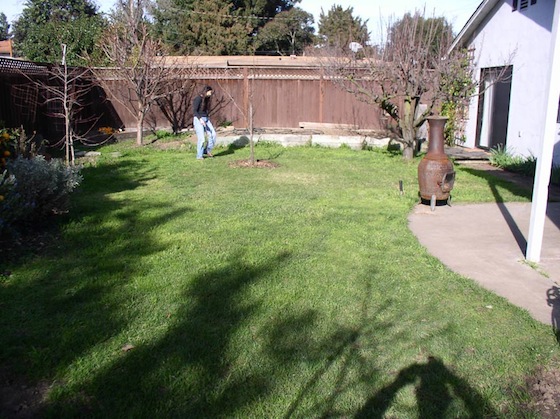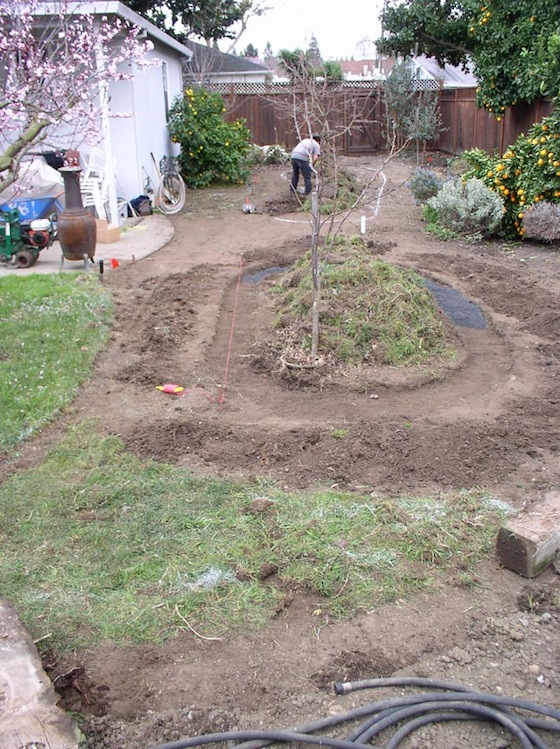
Flavor Notes by Robert Rich: Food, Wine, Restaurants & Recipes

Robert Rich narrates a back yard tour with culinary garden and drip irrigation.
Edible Landscape
A photo essay about our little back yard farm
For years I wanted to remove our back lawn and replace it with raised beds full of vegetables, using drip irrigation. A lawn is a silly waste of water in our dry Mediterranean-style climate.

Most of the designs for edible landscapes that I saw online used wooden raised boxes that imposed a utilitarian look upon the space, with straight paths and rectilinear shapes. I wanted curved paths and more natural forms for the raised areas.

I needed help to tackle this big project, so I contacted a local landscape company called Pazmany Brothers. I had watched them install a beautiful xeroscape garden with native plants in a townhouse complex nearby. They had never received a request like mine before, to remove a lawn and improvise a culinary landscape, working together with my help, and on a tight budget. I accepted their very reasonable bid; and then we had to wait for the heavy late winter rains to stop.
I discovered some interlocking landscape blocks designed for retaining walls, and we calculated the approximate amount to build 3-blocks high with the curves I wanted. We ended up using 3 pallets of blocks, although we were able to return an extra fourth pallet after we learned we over-estimated our needs.
Pazmany's workers were very patient with me as I kept re-shaping the curves with a spray can of marker paint. I wanted the curves to feel natural, with no straight lines, and once they started shaving the soil for a foundation it would be very hard to change the shape later.
Above, you can see how we created a drainage area using lattice brick that later gets hidden under the gravel.

For the drip irrigation system, we adapted our existing sprinklers by placing one pressure adaptor onto a PVC riser in each island that needed water. (The PVC risers had once been lawn sprinklers.) Each of those adaptors tees into two 3/4" diameter flexible pipes which can be pierced to feed many small drip lines, each fitted with a choice of spray nozzle, bubbler, or soaker line. That next summer, our water use dropped by 30%.
Our biggest challenge in the garden probably comes from the amount of shade we receive from surrounding buildings and trees. We have very few areas of the garden that receive full sun all day long. This limits our choices of where to plant. The tomatoes often do better in pots against a south-facing wall, or up against the fence where they can get some reflected heat.
Our other challenge is snails and slugs. I try to keep the garden organic, but I admit that I do use some snail-bait sometimes, especially in the wet early Spring months. I have tried using lids filled with cheap beer - they catch a few snails, but at a certain point those little suckers won't let any new sprouts grow. They especially like young squash and peas. We also have problems with cabbage loopers in our beets and chard. These are tiny moths whose larvae eat the centers out of the leaves, making them very unappetizing. We haven't found a good organic cure for those, nor for the powdery mildew that tends to affect our peas toward the end of their season.
Our somewhat cool bay-influenced climate also prevents us from growing some more intensely heat-loving plants like corn, bell peppers or eggplant. We have very good luck with beans, cucumbers, hot peppers, chard and beats (despite the loopers), carrots, strawberries, for example; and our arugula is such an aggressive grower that we spend more time trying to tame it than coddle it: it. We get a daily serving of salad that grows like a weed.
This year we're having very good results with a type of French cantaloup that has a bright-flavored green interior, a bit like honeydew. We started these from seeds harvestedf from last year's crop, which had previously come as a gift from Provence. There might be a similar vareity we have seen sold as "Eden's Gem." When young they still look smooth, but they'll get webbed with gray, green and orange underneath when ripe.
One of the many reasons I want to avoid pesticides here, is that I love to see the native amphibians and reptiles inhabit our little yard, and they are far more sensitive to these things than we are. I worry about how snail bait might affect the arboreal salamanders which sometimes go for a swim in the fishpond.

We found this lovely young gopher snake sniffing around one afternoon, hopefully finding some of the mice that come to eat the bird seed (and stay to nibble on the tomatoes). I know it made a home here for at least a few weeks, because I saw a shed snakeskin over by the holes where the mice live.
I feel very lucky that we have enough of a back yard to create this little paradise, here in the sprawl of Silicon Valley. We shouldn't foget this used to be called the "Valley of Hearts' Deight," that we live in such a gentle climate that we can grow things year-round. I see so many patches of our rich clay soil go to waste in our crowded region, covered with wasteful lawns or simply paved over; when an edible landscape can increase the beauty of our lives while also feeding our families with the freshest, healthiest food imaginable.
- Robert Rich, July 2012